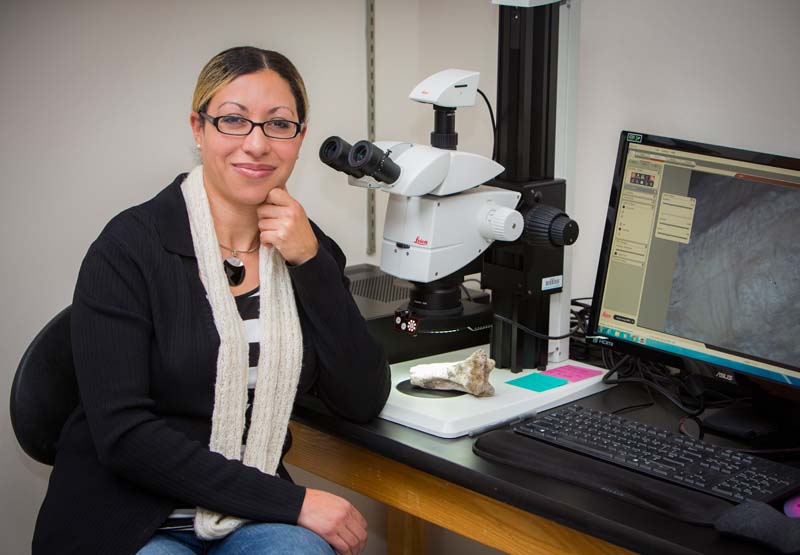Uncovering the secrets of bones
DiGangi’s work focuses on forensic anthropology.

Elizabeth DiGangi’s passion for anthropology has seen her travel the world while pursuing a way to better understand it. “Anthropology explains to me how the world works,” DiGangi says. “I had been taught that there are these universals about the way the world works, and anthropology corrected and yet expanded upon that for me.”
As an assistant professor of anthropology at Binghamton University, DiGangi’s studies center around analyzing skeletons and drawing conclusions about who a person was from their bones. “What I’m interested in, in particular, is forensic anthropology and bioarchaeology, so I work with human skeletal remains,” DiGangi says. “What I find most rewarding about that is it’s a puzzle for me. I enjoy having a skeleton laid out on the table and trying to figure things out about who that individual was when alive.”
After receiving her doctorate from the University of Tennessee in 2008, DiGangi decided to work as an independent contractor in Colombia for the U.S. Department of Justice to help instruct anthropologists in the country. “My job as a forensic advisor was to mentor and work with the forensic anthropologists in particular, but also the professional forensic pathologists and odontologists,” DiGangi says. “Anybody whose job it was to excavate and analyze human skeletal remains, it was my job to work with them to increase their skill set.”
In Colombia, she developed training courses in a range of subjects including forensic archaeology, bone trauma analysis, research methods, and osteology, or the study of bones. “We tried to get their skills up to where they needed to be so that they could excavate and do skeletal analyses,” DiGangi says. “In addition to the training course, I also did a lot of mentoring in labs one-on-one, so going into the labs and working with them on accreditation and setting up protocols.”
DiGangi and her colleagues at the Department of Justice also created a new forensic anthropology laboratory in Medellín, Colombia, for casework, instruction and research. The Centro de Identificación Humana opened in 2012. “There were several different laboratories doing forensic anthropology scattered throughout the country,” DiGangi says. “All of these labs were part of what were four, at the time, different government agencies doing that work. The thought was to collapse the efforts so that they are a little more cohesive within a more centralized location.” Despite her accomplishments in Colombia, DiGangi wanted to return to the world of academics and came to Binghamton University in 2013.
“I had wanted to go back to academia for a while; I really missed it while I was in Colombia,” DiGangi says. “I always knew that doing the contract work wouldn’t be my life forever. I knew that I wanted an academic position; I wanted to get back into research and back to teaching on a regular basis.” Binghamton was an ideal match for the New York native and SUNY Buffalo alumna. “Since I’m from New York, I was familiar with the University’s reputation — how excellent it is,” DiGangi says.
“To have the opportunity to work here is definitely a privilege.” DiGangi’s current research involves developing biological profile standards. Upon examining a skeleton, an anthropologist can use standards to estimate certain things about the person such as sex, age at death, stature and ancestry. “We have a certain set of standards that we use when we have an unknown skeleton in front of us,” DiGangi says. “The standards that we use typically come from the United States and American population.
There are problems when you take the standards developed for one population and you apply them to another population because things are different about different populations. Stature, or height, is a great example of this. If you travel the world, you find that on a population level, there are differences in terms of height. These differences exist for a lot of different reasons — nutrition level, exposure to pathogens, genetics, etc. — but knowing these differences exist make a difference when trying to estimate stature for a given population of people.”
DiGangi is working on creating population specific standards that will make analysis easier in different parts of the world. Recently she has been working on standards in Algeria with a colleague. This work returns to why DiGangi fell in love with anthropology in the first place. “Anthropology explains why people have different practices around the world,” she says. “I had never really understood the mechanics of the world before my first anthropology class, and I had never understood about cultural differences before, but anthropology illuminates human similarities and differences in a way that contributes to understanding and respect.
“I really believe it’s one of the few disciplines that can truly save humanity, if we all stop and pay attention to what it has to teach us.”
